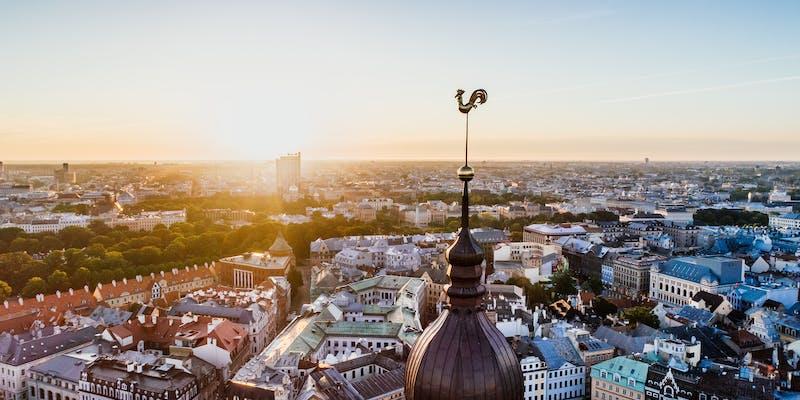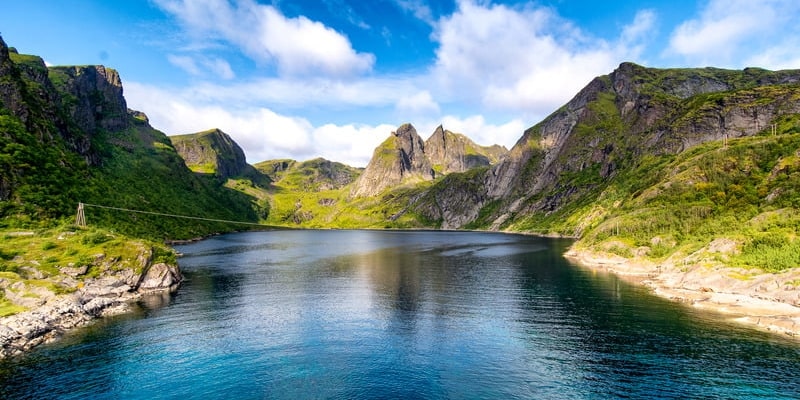Latvia country is an undiscovered gem in the Baltic area. There are many reasons to consider Latvia Europe's most beautiful country. From Riga's bustling downtown to the peaceful seaside, Latvia is a tale of natural beauty and historical wealth. Eight diverse aspects await discovery on a road trip or during the seasons.
The city of Riga charms with its cobblestone alleys and unique buildings, decked with flowers in summer and snow in winter. Latvia's 500-kilometer-long beaches, flanked by pine forests, are a hidden gem. Beyond, medieval castles and manor homes tell their own cultural stories. Latvia's cities and villages, from Kuldiga to Cesis, are rich in history and beauty, while bogs and moorlands offer natural refuge. Latvia's food, from potato pancakes to rye bread, enhances its appeal. The following qualities make Latvia country a viable contender for Europe's most beautiful country:
Pretty Cobbled Streets of Riga
Latvia's capital, Riga, is showcasing its beauty via its historic town, a museum of history and architecture. This beautiful metropolis merges nature and culture, changing with the seasons. Summer brings a kaleidoscope of bright blooms to Riga's historic center, while winter brings beautiful snow. Old Town Riga is a living canvas of historical and architectural marvels, beckoning investigation and appreciation. Latvia's complex story is told by the House of Blackheads, a medieval palace, Riga Castle, and St. Peter's Church, with its panoramic vistas.
Riga is Latvia's capital and a living witness to its ageless charm, with each cobblestone whispering stories of tenacity and cultural richness.
Coastal Sceneries
Latvia's seaside beauty goes beyond its capital. The country's 500-kilometer Baltic Sea white-sand beaches are undisturbed. Urban beaches in Liepaja and Ventspils are vibrant, but Latvia's true coastal beauties are concealed in pine forests. West Coast travel displays nature's masterpieces in Lapmezciems, Ragaciems, and Klapkalnciems. The Baltic Sea creates a tranquil scene that invites tourists to Latvia's unspoiled beachfront. While Sauklrasti, Tuja, and Salacgriva offer tranquility on the eastern shore, the Baltic's rhythmic waves meet exquisite sands. These beaches highlight nature's beauty and Latvia's dedication to beach preservation. Walking along these remote coastlines is a journey to the Baltic coastline's unspoiled heart, where waves and pine trees create an unmatched harmony.
Bogs and Moorlands
Visitors to Latvia's bogs and moorlands get a unique and pleasant natural experience. Kemeri National Park, near Jurmala on the seashore, is a fascinating natural marvel with various landscapes. In the center of Kemeri National Park is the Great Kemeri Bog, a vast wetland forest and small coastal lakes. Conservation and nature's delicate balance distinguish this bog. The park has wooden walkways and watchtowers to help tourists navigate this unique habitat without damaging the delicate ground. Kemeri National Park protects endangered species, rich plant life, and its attractiveness. The park attracts birdwatchers and nature lovers due to its environmental protection.
Ancient Latvian Castles

Latvia country has a rich cultural heritage, with medieval castles and manor homes dotting the countryside. Latvia's castles and manor houses preserve the nation's culture and offer a trip through time. These architectural wonders tell stories of past eras and are significant in Latvia's heritage. Here are a few famous Latvian Castles:
- Cesvaine Palace, a mixture of styles, represents Latvia's architectural variety. Between 1890 and 1897, Gothic, Art Nouveau, and Romanesque styles blend to produce a stunning building. Cesvaine Castle Park's 70 tree and shrub species offer a botanical touch.
- Turaida Castle in Gauja National Park was erected for Albert of Riga around 1214. The castle, part of the Turaida Museum Reserve, guards Latvian heritage and offers panoramic views.
- One of Latvia's most notable castles is Cesis Castle, erected in the 13th century. It has shaped Cesis for ages. Visit the castle's high tower for a stunning perspective of Cesis Old Town.
- Rundales Castle on the Zemgale Plains has Baroque and Rococo architecture. One of Latvia's two largest baroque castles, it was built for the Duke of Courland and is lavish.
- Bauska Medieval's strategic location at the confluence of the Musa and Melemele rivers into Lielupe beautifies Latvia's medieval scenery. The Dukes of Courland lived in a 15th-century castle with a 16th-century addition.
Europe's Widest Waterfall
The Venta Rapid, Europe's widest waterfall, is near Kuldiga, Latvia. Its massive size makes this natural wonder stand out at 650-820 feet. Despite being only six feet tall, the waterfall's breadth is breathtaking. The Venta Rapid's size and immersive experience set it apart. Walking along the waterfall is a unique experience due to its breadth. Spawning fish jump across the Venta Rapid in spring and fall. Kuldiga adds a lovely historical flavor to this natural wonder. The Venta Rapid in Kuldiga is a remarkable stop in Latvia's diverse and compelling landscapes, blending nature's majesty with human history.
Latvian Cities and Towns
Latvia's charm extends beyond its gorgeous scenery to its charming cities and villages, each with its history. The beautiful building in Kuldiga shows Latvia's artistic richness. Its gorgeous Old Town and Europe's largest waterfall, Venta Rapid, attract exploration. Kandava, founded in 1230, provides a historical tour of its ancient core. The Old Town Square and 14th-century tower remnants reveal this lovely city's history.
Central Latvian people town Cesis attracts with its rich history. Cesis Castle, now the Cesis History Museum, and its park offer peaceful places to explore Latvia's past. Latvia's west coast cities of Liepaja, Ventspils, and Jurmala, a world-class beach resort, add to its attraction. Hidden gems in eastern Latgale provide cultural variation to Latvia's tapestry. These cities and villages perfectly show Latvia's cultural history, historical legacy, and current attractiveness.
Latvian Food

Each dish in Latvia's cuisine tells a narrative of tradition and flavor. Latvian gastronomy is a tapestry of tastes with timeless meals. One of Latvia's culinary highlights is the potato pancake (kartupeļu pankūkas). Golden pancakes made with grated potatoes, eggs, flour, salt, and pepper are delicious. They are a cozy Latvian meal topped with sour cream and lingonberry sauce. Also, Grey peas (pelēkie zirņi ar speķi) are Latvia's national dish. This stew with local grey peas, fried onions, and sliced speck was cleverly made from preserved and dried foods.
The country of Latvia's favorite sorrel soup contains beef stock, chopped sorrel leaves, pearl barley, onions, potatoes, and lemon juice. This delicious soup shows Latvia's love of seasonal produce. Latvian food tells a narrative of cultural persistence in every bite, with generations-old recipes. Latvia's cuisine invites inhabitants and visitors to enjoy the authenticity and heritage of each dish.




